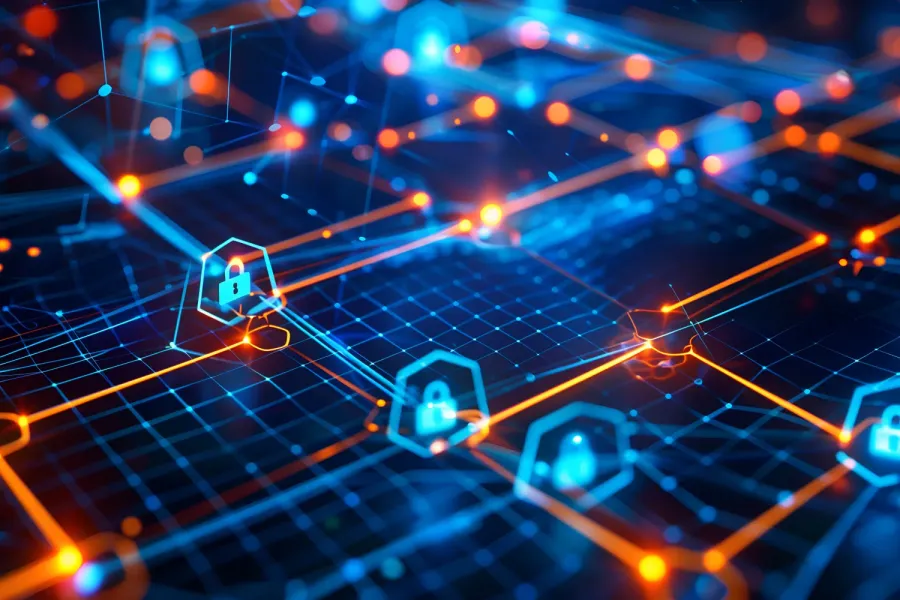
It's more critical than ever to know how to use digital communication while keeping personal and sensitive information safe.
This blog explores end-to-end encryption (E2EE), a method that shields data from unauthorized access as it moves from sender to receiver.
Understanding E2EE's mechanics, applications, and critical role in modern cybersecurity is essential for anyone concerned about digital privacy. Read on to learn more about how and why to use end-to-end encryption.
What is end-to-end encryption (E2EE)?
End-to-end encryption, or E2EE, is a secure communication method that keeps your messages private.
When you use E2EE, your message is scrambled into unreadable text from when you send it until it reaches the intended recipient. This recipient, and only this recipient, has the key to decrypt the message and read it.
Unlike other encryption methods that protect data only during certain transmission stages, E2EE ensures your communications are shielded from all outside parties. E2EE makes your data unrecognizable to hackers, internet service providers, and even the platform you're using. This makes it one of the most secure ways to share sensitive information over the internet.
How does end-to-end encryption work?
End-to-end encryption transforms your messages into a secure format from when you send them until the intended recipient opens them.
Only the recipient's device has the unique decryption key to unlock the message. It ensures that no one else can read the content.
This process uses complex algorithms to encrypt the data you send online.
When you send a message, it's locked using the recipient's public key. It can only be unlocked by their private key, also known as their secret key. The private key is securely stored on their device.
This dual-key system is a fundamental aspect of what is known as asymmetric encryption. It's a common method underpinning most modern E2EE protocols.
Whether using a messaging service like WhatsApp to send a personal message or conducting a secure transaction, the encryption process remains effective. It will safeguard your data against hackers, surveillance, and breaches.
What are the main components of E2EE?
End-to-end encryption (E2EE) relies on several crucial components that secure data.
The foundation of E2EE is the use of private and public keys.
The public key encrypts the data, turning it into a format that can only be read by someone with the corresponding private key. The private key is securely stored on the recipient’s device, ensuring that only they can decrypt the received message.
These keys are part of a broader system known as asymmetric encryption. The keys perform opposite functions but are mathematically linked.
This system is crucial for secure communications. It ensures the encrypted data remains unreadable even if the message is intercepted without the private key.
Each message uses a unique encryption key, significantly enhancing security. This is done by preventing potential attackers from decrypting messages en masse if they get access to a single key.
The decryption key is another vital component. It unlocks the encrypted data once it reaches the intended recipient. This process occurs seamlessly without the user needing to take any action.
This ensures a smooth experience while maintaining high-security standards. The decryption key method is used widely in messaging apps like WhatsApp. It's found especially when sensitive information is exchanged, like credit card transactions or sharing personal data.
Together, these components form a strong defense against common cyber threats. This includes man-in-the-middle attacks, where attackers attempt to intercept and decrypt transmitted data.
By encrypting messages end-to-end, E2EE ensures that only the sender and the intended recipient can access the content of their communications. And ensure that there is no possibility for intermediaries or even service providers to read the messages.
What are some common applications for E2EE?
Widely known messaging apps like WhatsApp and Messenger employ end-to-end encryption to ensure that only those participating can read what's sent.
Messages are locked, and even the service providers hosting these communications cannot access the encrypted messages.
Beyond messaging, end-to-end encryption plays a pivotal role in securing online financial transactions. When you use your credit card online, end-to-end encryption helps protect your sensitive data from potential interception by cybercriminals.
This security measure ensures that your financial details are transformed into a securely encrypted format.
This technology also extends to personal data protection across various platforms. It safeguards email, files, and even chats from unauthorized access.
It prevents hackers from stealing personal information or protecting against malware. End-to-end encryption is the shield that keeps sensitive information secure across different digital environments.
Users can significantly mitigate the risks posed by cyber threats. This is why adopting services prioritizing end-to-end encryption is not just advisable but essential for maintaining privacy and security in our interconnected world.
What are some challenges and limitations with E2EE?
Like everything, end-to-end encryption comes with its own set of challenges and limitations.
While it is a powerful tool for protecting data, its widespread adoption is hindered by technical, legal, and ethical hurdles.
One major challenge is the complexity of deploying end-to-end encryption across different platforms and devices. Ensuring that all endpoints are secure and that the encryption does not interfere with user experience requires substantial effort and expertise.
This complexity can deter service providers from fully integrating end-to-end encryption into their systems.
From a legal perspective, end-to-end encryption poses significant challenges for law enforcement agencies.
The strong protection it offers also makes it difficult for authorities to access data, even when legally warranted. This has led to ongoing debates about the need for backdoors that allow law enforcement access in exceptional circumstances.
However, cybersecurity experts argue that creating these backdoors would weaken encryption security and expose data to potential exploitation by hackers.
Moreover, the ethical implications of denying law enforcement access to encrypted data must be balanced against the individual's right to privacy. This debate is complex and varies significantly across different legal jurisdictions. It reflects broader societal values and priorities regarding privacy and security.
The bottom line
End-to-end encryption is crucial for protecting digital communications. It ensures that sensitive data, whether a WhatsApp message or a financial transaction, remains secure from when it's sent until it reaches the intended recipient.
This encryption method is the backbone of modern data security, preventing hackers, malware, and service providers from accessing private information.
Despite its security benefits, end-to-end encryption faces challenges and criticisms, particularly from law enforcement agencies. E2EE can hinder legal investigations, leading to calls for built-in access points or backdoors. However, creating such vulnerabilities would defeat the purpose of using this secure technology, potentially exposing users to more significant risks.
As technology evolves, the future of end-to-end encryption will focus on enhancing security measures to protect against emerging threats. It will continue to extend into more platforms, ensuring users' data remains private and secure across all digital spaces.
Superhuman is the fastest email experience ever made, and we're committed to providing secure communication solutions. Explore how Superhuman can help you and your team scale productivity.




